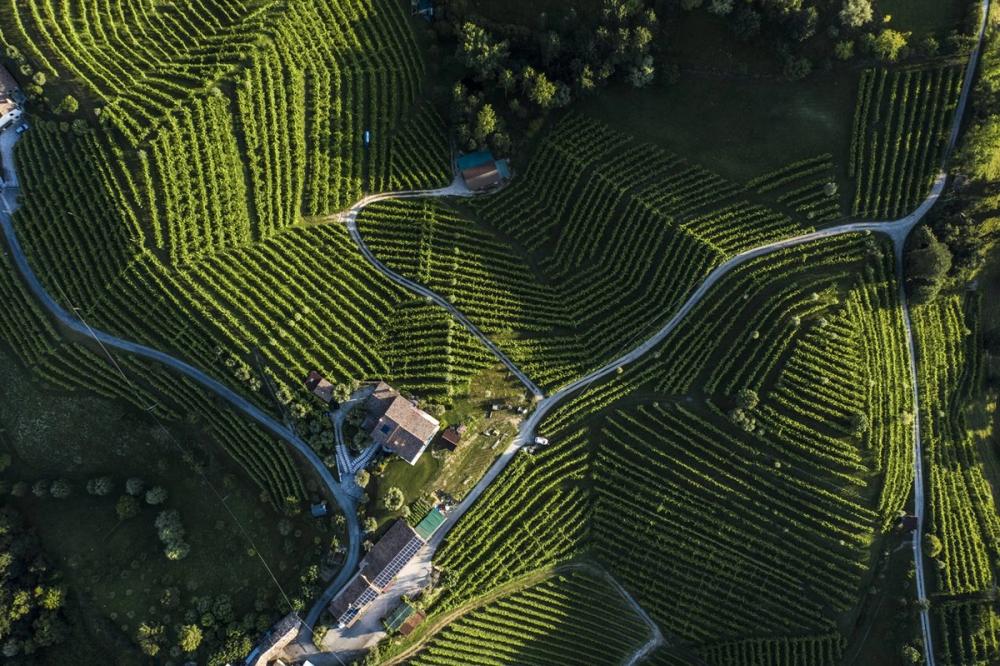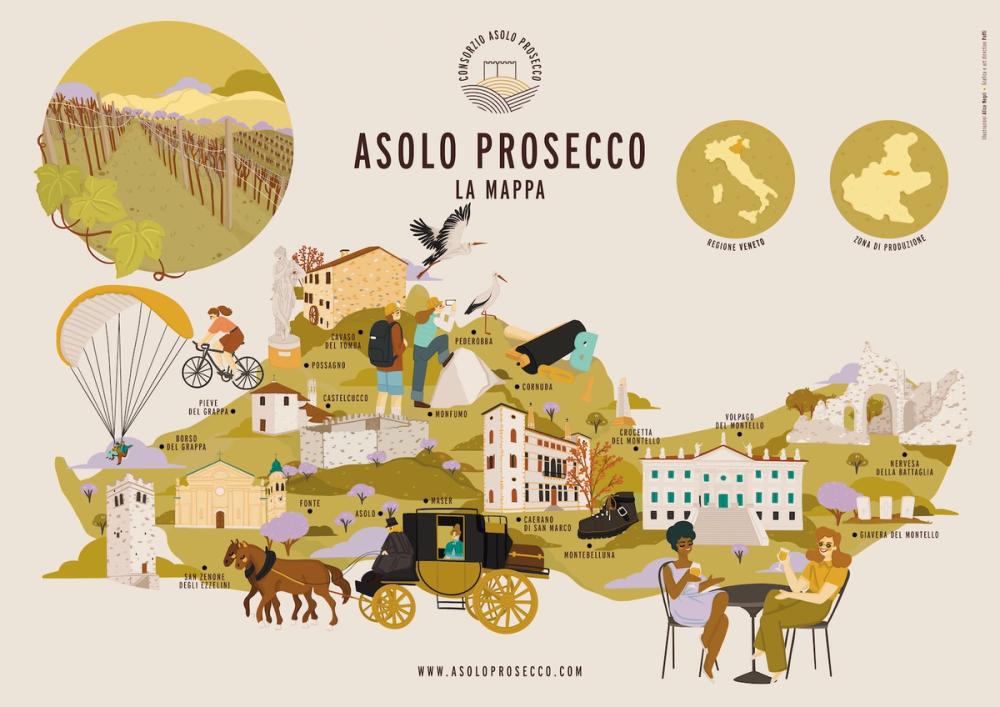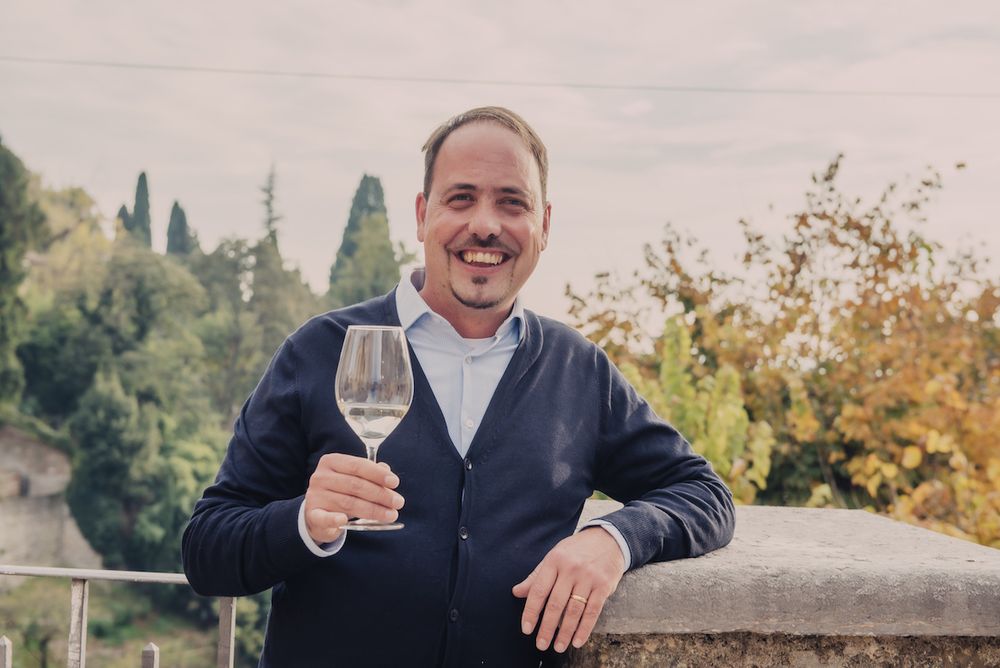“Asolo Prosecco’s drier style and the salinity work well in the on-trade as a food-pairing sparkling wine. And as a ‘boutique’ appellation, it can equally appeal to more engaged wine lovers,” writes De Pasquale.

With the 2022 production reaching around 25 million bottles, Asolo still has potential for growth
Prosecco’s roaring success seems unstoppable. In 2021, the total production of Prosecco coming from the low-lying DOC area was 627.5 million bottles. Conegliano Valdobbiadene and Asolo which are the two hilly DOCGs on the top of the Prosecco quality pyramid, produced 105 million and 21 million bottles respectively in the same year. Asolo is clearly the smallest appellation in the area. So exactly what is unique about it for it to be a stand-alone Superiore DOCG in the vast Prosecco universe?
The background and the key differences

In essence, the overall Prosecco DOCG zone is on the rolling hills covering a few communes in the province of Treviso, centred around the three townships of Conegliano, Valdobbiadene and Asolo, in the northeastern part of Italy. This is where the Prosecco story all begins. Piave River splits the area into two, which forms the geographical boundary of the modern day Prosecco Superiore DOCG zones.
To the west of the river, surrounding the medieval town of Asolo, is one of the historical areas where Venetian nobles set up their summertime villas during the Renaissance. It was back then, that the nobles started to hire workers to farm the lands surrounding the villas. Vineyards were established around the verdant hills of these three towns (mentioned above) that kickstarted the Prosecco phenomenon.
Conegliano firmly established itself as a winemaking and research centre since 1876 when the Cerletti Institute, the first school of winemaking in Italy, was opened. In 1923, the Institute for Viticultural and Oenological Experimentation was founded there followed by University of Padua which has an annex of its Oenology Faculty there.
Conegliano Valdobbiadene Superiore DOCG covers a much larger area, 8,710 hectares in total, whereas Asolo is just under a quarter of its size. Both have south-facing hills that is vital for producing high quality Glera. They even face the same climatic hazard where summer hails could be a problem. But when visiting the two areas, you will soon notice that in Valdobbiadene, many vineyards are equipped with hail nets but this is not the case in Asolo.
“In Conegliano Valdobbiadene, using hail net is a tradition, but in Asolo, producers tend to be small to medium size, they prefer to pay for the insurance covering such a damage rather than installing nets which could be costly to maintain,” explains Stefano Gava, technical director and chief winemaker of Villa Sandi, one of the biggest producers in the area making wines across all the Prosecco denominations.

The key difference between Asolo and the other regions is the soil
The real marked difference between the two DOCGs, however, is the soil. In Asolo, the limestone is nearly all morainic in origin, created by the force of melted glaciers millions years ago, carrying ice and rocks downstream and broken down along the way which formed boulders, pebbles and sand.
To the east side of the Piave River, in Valdobbiadene and Conegliano, there are less morainic soils but mainly conglomerate and marl. The differences in flavours, though subtle, do show when the wines are tasted side by side. Proseccos from Asolo tend to have what the locals call “sapidity” which denotes the sensation of minerality and salinity on the palate and are more floral and fragrant on the nose. Whereas wines from Conegliano Valdobbiadene will be fruit-driven and expressive. For the minerality flavours to shine through the glass, Asolo is a strong advocate of the drier style of Prosecco and spearheaded the initiative by adding the Extra Brut (<6g/l) category in 2014.
Is Premiumisation the way to go?
While the UK is the biggest export market for the generic Prosecco DOC and Conegliano Valdobbiadene Superiore DOCG, there is clearly room for improvement for the presence of Asolo Prosecco Superiore DOCG in the UK. Currently, the biggest export market for Asolo is the US. In the UK, most high-end restaurants would not even list any Proseccos in the fear of sacrificing the profit on Champagne sales. But are there opportunities for Asolo to tap into the premium Prosecco category?
Antonio Palmarini is one of the “Top 25 Sommeliers” in the UK in 2022 and a firm believer in the potential of premium Proseccos. He recalls his time in Sushi Samba when there was also the “no-Prosecco policy”, yet he was able to sneak in a premium “Cartizze” Prosecco (top tier Prosecco on the Conegliano Valdobbiadene DOCG quality ladder) at £120 on the list which sold really well.
For him, it demonstrates that there are opportunities for premium Proseccos in the UK on-trade. But he warns that “consumers still do not understand the difference between Prosecco DOC and DOCG, and the name sometimes are too long and too difficult to remember or pronounce.” In this case, the succinct name of “Asolo” clearly has an edge.
As for the off-trade, Sarah Knowles MW, Wine Society’s wine buyer for Italy, Champagne and North America thinks premium Proseccos remains a niche category for now.
“It’s great that Prosecco DOCGs offer customer choice and the chance for people to explore the category. At the moment we have a Cartizze listed and have listed Asolo in the past, however the majority of sales remain with the great value and good quality DOC Proseccos that we work with.”
Asolo as a Cru?

Ugo Zamperoni, President of Asolo Prosecco Consortium
Ugo Zamperoni is the President of Asolo Prosecco Consortium, and is fully aware of the challenges ahead. “Our biggest task is to raise the positioning and awareness of our products so professionals and consumers can appreciate the quality of Asolo Prosecco.”
For a small appellation in the massive Prosecco land, Asolo has only 2,000 hectares, merely 6% of territory is under vine, and 29% of the area is covered by forests. But with the 2022 production reaching around 25 million bottles, Asolo surely still has potential for growth. But growing quantitatively is not the focus, and the maximum production is capped at 30 million bottles in a bid to raise quality and to maintain the biodiversity.
Angelo Peretti, communication strategist for the Consortium thinks positioning Asolo as a Cru of Prosecco is the way to go.
“In my view, the Beaujolais type of cru concept is perhaps the best solution for us to communicate to wine professionals and consumers. This will clearly place Asolo as one of the top quality village Crus in the vast Prosecco territory.”
Whether it’s the cru concept or to work on the premium positioning, or both, Asolo Prosecco Superiore DOCG does tick all the boxes for having its unique identity that should exist on its own merits. Its drier style and the salinity work well in the on-trade as a food-pairing sparkling wine. And as a ‘boutique’ appellation, it can equally appeal to more engaged wine lovers. Perhaps it’s time to explore this DOCG with an open mind and see for yourself what Asolo can offer.
Leona De Pasquale is a wine educator with Camellia and Vine, and is now studying to be a Master of Wine. You can read a full profile of her here.
































